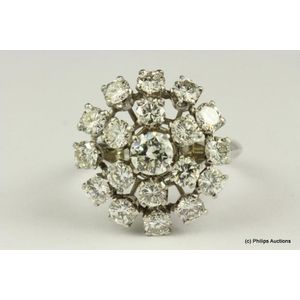Georgian 18ct Gold Cannetille Oval Brooch
You must be a subscriber, and be logged in to view price and dealer details.
Subscribe Now to view actual auction price for this item
When you subscribe, you have the option of setting the currency in which to display prices to $Au, $US, $NZ or Stg.
- Georgian - As an English stylistic period, Georgian is usually taken to cover the period from George I (1714) to the Regency of Prince George (1811-20), although the period from 1800 to 1830 is sometimes designated as the Regency period. During the Georgian period the great English cabinetmakers and designers such as Chippendale, Hepplewhite, Adam Sheraton etc., were all active.
Therefore there isn't a single 'Georgian style' as such and to say something is 'Georgian', usually means it was made between 1714 and 1830. This assumes we discount George V and George VI, both being from the 20th century.
The styles popular at the time of each reign were:
George I (1714-1727) saw out the last years of the Baroque period.
George II (1727-1760) reigned during the Rococo period.
George III (1760-1820) saw the last gasp of the Rococo, all of the early Neo-Classic 'Adam style' and most of the later neo-Classic 'Regency style'.
George IV (Prince Regent 1820-1830)encompassed the last of the 'Regency' style.
William IV's reign (1830-1837) was something of a no man's land (stylistically) and he wasn't a 'George' anyway. He covered the last glimmerings of 'Regency' and the start of the 'Victorian' style. - Cannetille Work - Cannetille work is a type of jewellery-making technique that involves the use of fine wire, typically made of gold or silver, to create intricate and delicate designs. The wire is shaped and twisted into various forms, such as leaves, flowers, and scrolls, and then applied to the surface of the jewellery piece. The wire is then soldered to the piece, and the excess wire is often removed to create a smooth surface.The technique originated in the 18th century in France and Italy, and was particularly popular during the Victorian era. It was often used to decorate brooches, bracelets, and necklaces, and was a highly skilled and labour intensive technique. Cannetille jewellery is known for its intricate and delicate appearance and is highly valued by collectors.
This item has been included into following indexes:
Visually similar items

An antique Australian greenstone brooch. Yellow gold. Weight 7.44 grams.

A striking snowflake diamond dress ring, 18ct white gold, made as a round panel styled cluster of double framed design, featuring a central fine quality brilliant cut diamond of approximately 0.60ct, claw set, spaced and framed by six smaller brilliant cut

A Victorian diamond pendant brooch, circa 1870, the domed and pierced brooch set throughout with old brilliant cut diamonds. Silver and gold. Weight 8.73 grams. Width 3 cm. For a similar example see p.156, 'Understanding Jewellery' David Bennett & Daniela

Diamond ring, early 20th century, of cluster design, centring on an early oval modified brilliant-cut diamond weighing approximately 1.18 carats, claw-set within a surround of old mine-cut diamonds together weighing approximately 1.00 carat, mounted in 18c
